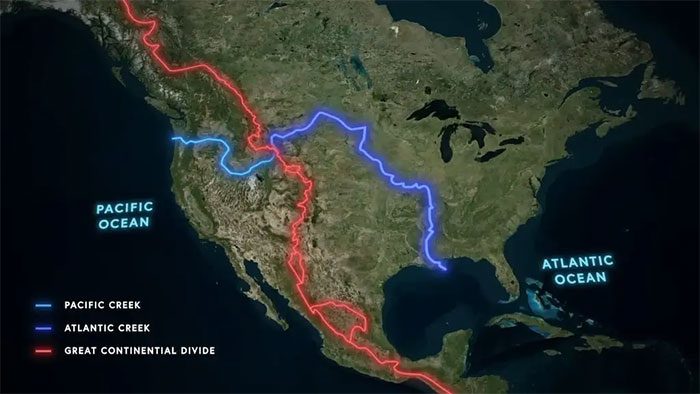In the world, there is a unique waterway that flows into both the Atlantic and Pacific Oceans, known as the North Two Ocean creek.
The map of North America illustrates the continental divide, a ridge stretching from Alaska south through the Canadian Rockies and down into Mexico. This is an invisible line that separates major river basins that flow into different oceans.

The North Two Ocean creek divides precisely along the continental divide.
Generally, if a raindrop falls to the west of the continental divide, it will join rivers flowing into the Pacific Ocean. Conversely, if a raindrop falls to the east of the divide, it will flow into the Atlantic Ocean or the Arctic Ocean.
Located in the Bridger-Teton National Forest of Wyoming, the high mountain meadows at Two Ocean Pass do not resemble a traditional pass at all. The slope of the pass is so gentle that when the meadows are flooded in the spring of a wet year, a fish could swim from the Pacific watershed into the Atlantic watershed!
The North Two Ocean creek divides precisely along the continental divide, forming the aptly named Pacific Creek and Atlantic Creek. An old wooden sign at the Parting of the Waters indicates that it is 3,488 miles from the Atlantic Ocean and 1,353 miles from the Pacific Ocean.
The Pacific Creek flows southwest towards the Snake River, while the Atlantic Creek flows northeast towards the Yellowstone River.
A recent study investigated a hypothesis that non-native lake salmon might have invaded Yellowstone Lake by swimming through North Two Ocean, rather than the initial assumption that they were illegally introduced by a person.
Researchers employed environmental DNA sampling, electrofishing, and angling to determine whether lake salmon or other non-native fish species were present in the waters near North Two Ocean.
While the origins of the salmon in Yellowstone Lake remain uncertain, the potential for non-native fish to cross through North Two Ocean in the future is a serious concern. To protect the native Yellowstone salmon, ongoing monitoring of these waters and proactive removal of non-native fish species may be necessary.


















































